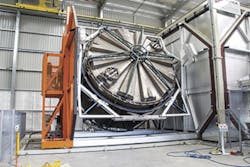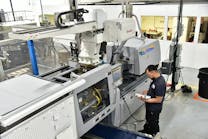Recent rotomolding innovations offer advantages such as speed, efficiency and energy improvements.
At the K show, Rotoline Brasil, Chapecó, exhibited the TNC rotomolding line, aimed at speeding the rotomolding process. Using automation, the new process lowers labor costs, reduces errors and shortens cycle times, GM Raphaeli De Luccas said. As a followup to positive reception the new line has enjoyed, the company is moving forward with plans to introduce another line later this year.
De Luccas said that the goal was to provide an alternative to blow molding for manufacturers attempting to make complicated geometric parts. The speed of the TNC line is comparable to a blow molding machine. Machines in the line, which includes the TNC 30 and TNC 40 models, have enclosed ovens and are suited to making multilayer parts.
De Luccas said the project was considered first in 2009, but the technology was not yet ready. Specifically, he said, process control was unsophisticated and resulted in frequent communication errors. But by last year, using new technology on variable-frequency drives, "we managed to automate and control almost the whole process."
The TNC's mold automatically opens and closes, and the machine also features automatic resin dosing, minimizing the chance for problems, such as over- or under-dosing or operator injury. Resin feeding of a second layer — typically also handled manually — has been automated, as well; a second layer of resin can be fed into the mold while it is inside the oven. This level of automation is made possible by precise mold-position control that allows the mold to be stopped within the oven in a certain position, where a tube can be used to introduce a second layer of material.
De Luccas said with the success of the TNC line, Rotoline is working on a rollout of even bigger machines that will be able to produce 6,600-gallon water tanks. The company is looking to launch the new TQ line this year, possibly in September at Rotoplas in Rosemont, Ill.
Like the TNC machines, the TQ line will feature automation that can dramatically reduce labor requirements and costs, worker risk and possible human error, De Luccas said. This will result in faster part manufacturing times and fewer defective parts or scrap.
Rotomachinery improves controls
Polivinil Rotomachinery SpA, Cerano, Italy, recently developed new machine software that accounts for part weight and helps with mold positioning. It applies to both the spiders of straight arms and the flanges of offset arms to keep the weight balanced. Operators can move molds using a PC and a mouse. The program will show any unbalanced point and propose a repositioning of the weight, the company said. The repositioning can be done without interrupting production. Rotomachinery said the development reduces mechanical stress and extends component life.
Using a PC or mobile device, the operator can check production and view the same pages as the touch panel that's on the machine; multiple machines can be controlled by one person.
Software features include a network analyzer for viewing and saving power, an extractable compact flash memory for loading programs and the capability of remote servicing through a modem. The software can display all process parameters, including the setting and display of all process parameters, such as temperature and rotation speeds, temperature curves for the cooking chamber in automatic/manual cycle; and recommended solutions for out-of-parameter conditions.
Rotomachinery also developed Regen, a method for capturing and using energy that is lost from the machine motors. Regen is a bi-directional power supply serving all the motors controlled by inverters that convert DC into AC current and return the energy generated during deceleration or stop. Regen takes the returned energy and uses it to power the other motors. When that power exceeds the machine's needs, Regen feeds other utilities, such as the facility's lights. A display shows the quantity of energy reused.
Another development for Rotomachinery has been the UFD System Upper Fan Duct, which is an extra hot-air pipe that recycles heat from the primary operation and directs some of it onto the molds. New, hot-air-blowing fans consisting of two turbines reduce the loss of hot air during the opening and closing of the oven doors. In combination with its Eco Mode System, the company said this provides an advantage, in which the burner is extinguished when the oven is empty and its doors are open, and the exhaust works at minimum power. The burner is turned off when the oven temperature falls below 200 degrees. Eco Mode is designed to reduce energy consumption.
Rotomachinery said the innovations are key when dealing with material changes, product weight changes, new mold testing or initial startup because different conditions affect cycle changes.
Allan Gerlat, correspondent
Contact
Rotoline USA, Kent, Ohio, 330-677-3223, www.rotoline.com
STP Rotomachinery Inc., Sherbrooke, Quebec, 819-846-2787, www.rotomachinery.com






